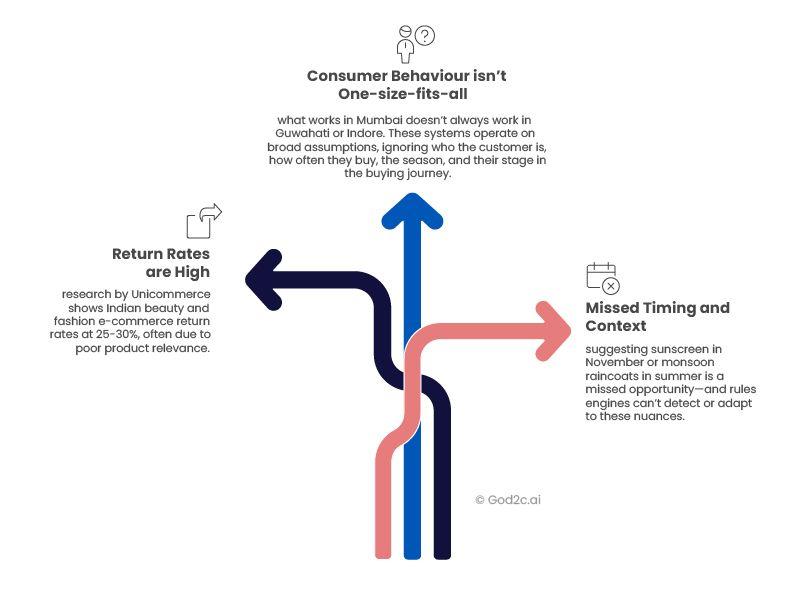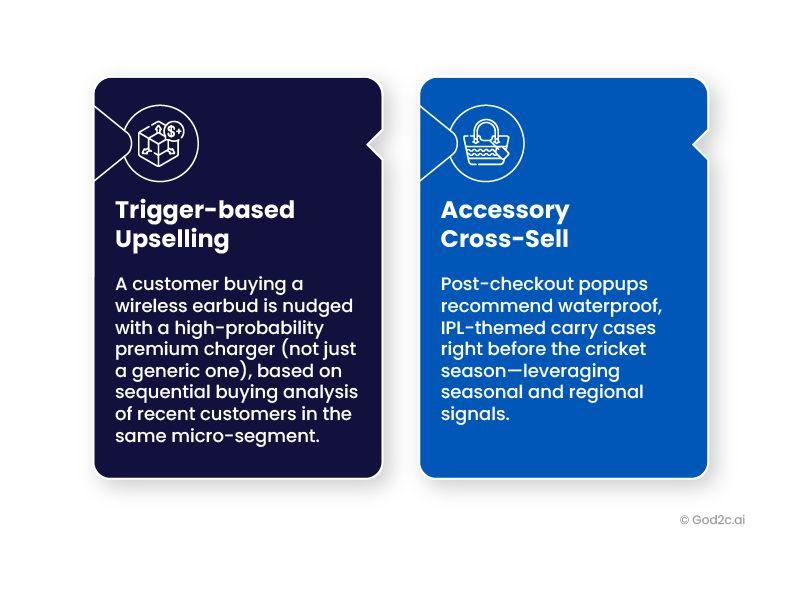ML-Based Recommendation Engines for D2C: Leveraging Buying History to Upsell and Cross-Sell
The direct-to-consumer (D2C) business in India is entering a new phase where data isn’t just a marketing asset but a key business driver. With over 800 brands now competing for customer attention and digital space, the economics of the industry have shifted. As customer acquisition costs (CAC) rise and product categories become more commoditized, Indian D2C brands are shifting their focus from acquisition to retention and growth.
According to a 2024 RedSeer report, the average CAC for urban D2C startups has surpassed ₹1,200, an increase of nearly 40% over two years.
But retaining customers alone isn't enough. Growth in D2C businesses depends on how much additional value you can extract from each customer, and that’s where machine learning-based recommendation engines come into play.
What started as a simple “People also bought” feature has evolved into sophisticated, adaptive systems that analyze a customer's entire buying history, micro-interactions, and context to decide not only what to show but also when and how to present it. For the D2C ecosystem, these engines are no longer optional; they are vital for boosting revenue, enhancing customer experience, and building brand loyalty.
Why Static Rule-Based Recommendations Fail for Ambitious D2C Brands
Traditional eCommerce platforms have relied on rule-based systems: if a customer buys Product A, then recommend Product B. However, in the Indian market, these static rules encounter several issues:
- Consumer Behaviour isn’t One-size-fits-all: what works in Mumbai doesn’t always work in Guwahati or Indore. These systems operate on broad assumptions, ignoring who the customer is, how often they buy, the season, and their stage in the buying journey.
- Return Rates are High: research by Unicommerce shows Indian beauty and fashion e-commerce return rates at 25-30%, often due to poor product relevance.
- Missed Timing and Context: suggesting sunscreen in November or monsoon raincoats in summer is a missed opportunity—and rules engines can’t detect or adapt to these nuances.

Understanding the Core of ML-Based Recommendation Engines
At their core, ML-based recommendation systems combine algorithms like collaborative filtering (user-to-user or item-to-item similarity), content-based filtering (based on product features), and increasingly, deep learning models capable of understanding temporal patterns and sequences.
Let’s take a D2C nutrition brand as an example. A customer might start with a basic whey protein pack. If that same customer, then explores immunity boosters and vitamin D supplements but doesn’t make a purchase, the system logs this interaction. Instead of relying on static rules, these systems adapt to user behaviour dynamically. They observe across sessions, categories, and devices to build a nuanced understanding of customer intent.
The next time the customer opens the app, a well-timed bundle recommendation such as whey protein, vitamin D, and an immune booster pack is shown, timed around typical replenishment cycles. These engines don’t just match products; they match intent and forecast purchase probability based on behavioural data, historical patterns, and contextual cues. Over time, this customer’s data contributes not only to their profile but also to a larger model trained to recognize patterns across thousands of similar customers.
What powers these models? It’s not just SKU-level data, but a broader range of inputs:
- Purchase frequency, order values, and product lifecycle data
- Time-based signals (recency of last interaction, gaps between purchases)
- Category preferences and browsing paths
- Cart abandonment behaviour
- Responses to promotions, discounts, and personalization attempts
- CRM history, support queries, and even regional festivals or seasonality
By continuously ingesting and analysing this data, the engine improves, not just at recommending, but also at anticipating what a customer is likely to need next.
Buying History as a Strategic Revenue Source
Buying history is the single most reliable behavioural data point available to D2C brands. It tells a story that customers care about, how often they repurchase, how their preferences evolve, and where the brand sits in their lifestyle priorities.
- Sequential Patterns for Upsell:
- ML tracks common purchase journeys (e.g., cleanser to toner and then moisturizer).
- Enables journey-based, personalized product recommendations.
- Dynamic Tiered Selling:
- Helps identify when a user is ready to move from trial packs to full-size or premium SKUs.
- Example: Frequent reorders of ₹199 hair oil may trigger a recommendation for a subscription or higher-tier variant.
- Predictive Cross-Sell Based on Cohorts:
- ML detects when users resemble high-value customer cohorts and nudges accordingly.
- Tailors cross-sells based on past offer responsiveness and purchase timing.
It doesn’t end at the product level. Buying history helps identify life stage transitions. A customer buying baby lotion and wipes may soon need toddler-safe bath products. These transitions aren’t guesswork; they’re derived from pattern recognition across cohorts.
Upselling and Cross-Selling with Machine-Learning
Upselling and cross-selling are not the same, and ML engines treat them differently. Upselling involves encouraging a customer to buy a more expensive or premium version of what they were already interested in. Cross-selling involves introducing complementary products that enhance the core item.
Let’s take an Indian D2C electronics brand like boAt.
boAt, India’s largest audio wearables brand, scaled up its ML recommendation engine in 2023.
- Trigger-based Upselling: A customer buying a wireless earbud is nudged with a high-probability premium charger (not just a generic one), based on sequential buying analysis of recent customers in the same micro-segment.
- Accessory Cross-Sell: Post-checkout popups recommend waterproof, IPL-themed carry cases right before the cricket season—leveraging seasonal and regional signals.

Result: According to boAt’s internal analytics for 2024, ML-powered sequenced recommendations increased attachment rates for accessories by 15% and reduced stockouts for newly launched variants.
How an ML-Powered Engagement Platform (e.g., GoD2C.ai) Works
- Unified Data Layer: Pulls from eCommerce, CRM, marketing, and support tools to build rich customer profiles, enriched with behavioural and segment attributes.
- Intelligent Model Stack:
- Collaborative filtering to leverage cohort behaviour.
- Content-based models to match user preferences with item attributes.
- Sequential/time-series models (like Transformers) to map customer journey and upsell timing.
- Real-Time Recommendation Serving: Enabling sub-300ms delivery across site, mobile app, email, and messaging channels.
- Auto-Feedback Loop: Continuously collects CTR, addtocart, purchase, and return data to refine model output without manual rule-making.
- Dynamic Segmentation Engine: Updates customer microsegments (e.g., repeat buyers, highLTV, discountsensitive) in real-time for precise targeting.
Conclusion
Success in D2C business will not come from running more ads or adding more SKUs; instead, it will come from understanding customers better than anyone else. Machine learning-based recommendation engines give D2C leaders in India the ability to do just that, at scale.
GoD2C.ai offers compelling access to an ML-based customer engagement platform without the overhead of building and maintaining an engine in-house. For brands that need quick time-to-value paired with Indian-context intelligence, it’s a strategic partner and accelerator.
If you’re evaluating how to unlock higher CLTV, improve upsell/cross-sell conversions, and retain customers in a cost-efficient way, GoD2C.ai deserves a close look.
Let’s get started!
Schedule a discovery session with a GoD2C.ai specialist to map their engine onto your customer data, roadmap, and revenue goals.

